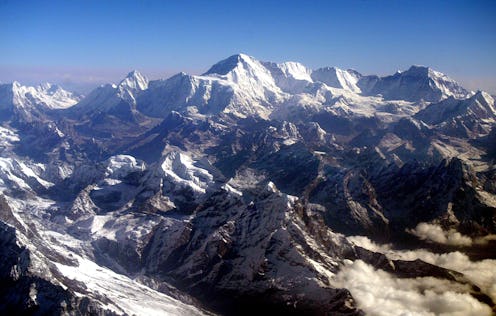News
Here's What Makes Climbing Mt. Everest So Dangerous — Especially When It's Crowded

Mt. Everest may be the most famous mountain in the world, but summiting the more than 29,000 foot tall landform is no simple task, even for avid hikers. Although causes of death among those who die while trekking up the mountain may vary, most people understand that attempting to climb the mountain comes with a certain amount of risk. There is more than one reason why Mt. Everest is so dangerous for climbers, of course, but a lot of them have to do with its monumental height.
MountEverest.net, a website devoted to those interested in climbing Mt. Everest, has outlined some of the challenges that hikers should consider when planning a trip. Among those challenges are avalanches, falling rocks, dehydration, and exhaustion. Recently, reports indicate that there has been at least one additional danger for those attempting to summit Everest — overcrowding. But make no mistake, hiking guides indicate that trek is already dangerous enough, even without hiker congestion near the top.
In addition to reminders about proper hydration and footwear, the website Mountain IQ recommends that prospective Everest climbers crosstrain to build their stamina in advance of attempting a climb. They suggest, for example, incorporating aerobic workouts and leg-strengthening exercises on top of a regimen that includes walks lasting up to five hours long.
Endurance, indeed, is key, according to experts. The British Mountaineering Council reports that most treks up Everest take about two months to complete. Climbers begin arriving at Everest in March, according to the council, with the goal of summiting the mountain sometime in May.
Altitude sickness, caused by a lack of oxygen, is another danger that Everest's hikers have to worry about, according to Live Science. Sometimes referred to as acute mountain sickness, per Live Science, the adverse physical reaction can potentially lead to "buildups of fluid in the lungs and brain." Those experiencing symptoms, which include breathlessness, confusion, and coughing up pink fluids, may have to wait a full day or two before climbing any higher, or else descend, according to the website.
2019 has marked one of Everest's most deadly climbing seasons, according to reports. Ten people are have died in the last two months, according to The Hill. A New York Times reports indicates that overcrowding near the top of the mountain is likely a contributing factor when it comes to the higher than usual mortality rate.
Arizona doctor Ed Dohring told the paper that Everest's summit had been "like a zoo" when he approached it earlier this month. He described having to wait hours to reach the mountain's top, as people crowded the summit proper to take photos. Some of Everest's recent deaths have also been attributed to lengthy descent times, caused in part by the mountain being abnormally congested, according to the Times.
Descending Everest can be particularly dangerous if it is delayed for too long, according to NBC News. This is because, the news outlet reports, the longer you remain at such a high altitude, the greater your risk of developing both altitude sickness and/or frostbite. Long lines, reports indicate, can produce precisely that kind of situation.
Climbing Mt. Everest comes with many challenges, according to experts. And reports indicate that, in a place where bad weather and altitude can cause deadly problems of their own, traveler overcrowding only adds to the potential dangers.